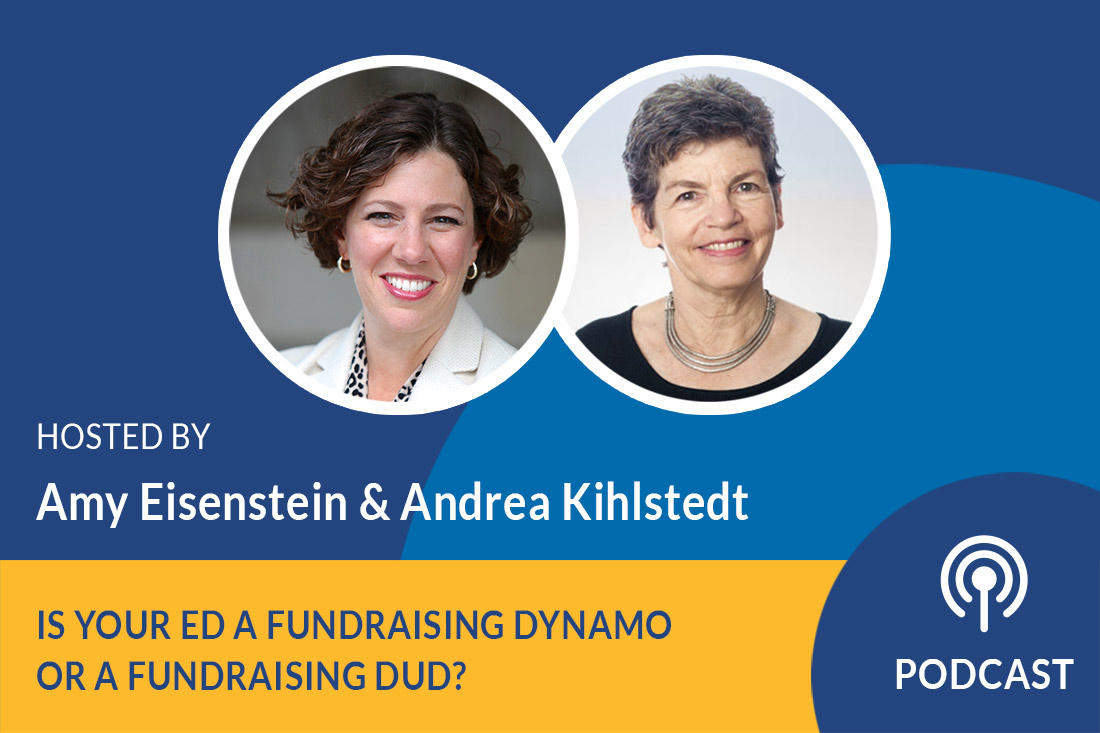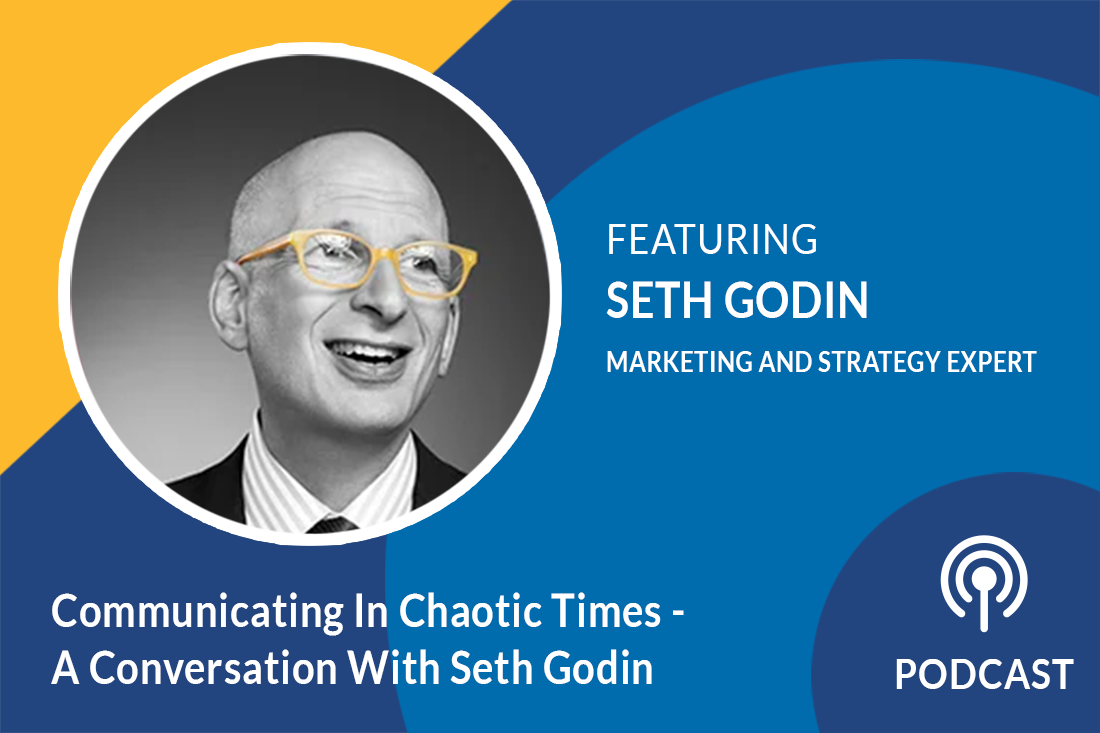Podcast: Is Your Executive Director a Fundraising Dynamo or a Fundraising Dud?

Season 3, Episode 5
In this session, capital campaign experts Amy Eisenstein and Andrea Kihlstedt discuss how to prepare your Executive Director for a capital campaign — whether that person is great at fundraising or not. You’ll learn how to approach even a recalcitrant ED in a way that will help get them ready for their role in your capital campaign.
Listen Now:
Amy Eisenstein:
Is your Executive Director a fundraising dynamo or a fundraising dud? Stay tuned to find out.
Hi, I’m Amy Eisenstein, CEO, and co-founder of Capital Campaign Pro, and I’m with my colleague and co-founder, Andrea Kihlstedt. And today we are talking about the role that your Executive Director needs to play in a successful capital campaign.
Andrea, kick us off.
Andrea Kihlstedt:
Oh, Amy, your title of fundraising dynamo or dud just made me laugh because of course people, there are Executive Directors who are dynamos, who are just terrific at it, who love the role of hobnobbing with and being a real part of the major gift fundraising process, and they’re amazing because they can do it so well.
And then there are Executive Directors who really do a great job of running the organization. They’re mission-driven, they’re active and engaged and excited about what the organization does, but you put them in front of a major donor and their knees turn weak. They’re just not good at it.
Amy Eisenstein:
Yes.
Leveraging the Talents of Your Executive Director During a Campaign
Andrea Kihlstedt:
The reality is that just because the campaign is coming, you can’t turn a dud into a dynamo. You just need to think about it differently.
Amy Eisenstein:
I think that’s exactly right.
So the goal is not to turn every Executive Director into a fundraising dynamo, but it’s about leveraging their talents and strengths and laying out their roles and responsibilities in a campaign. And the reality is that any Executive Director — no matter what their fundraising, comfort level or skill — plays or needs to play a very significant role in your capital campaign.
Let’s get started with your fundraising dynamos, because even they are going to have trouble and struggle potentially with all the added responsibilities of a campaign, even if they’re a fundraising dynamo and they have great relationships with donors and are comfortable with asking. Taking on a campaign when you’re a busy Executive Director is a significant responsibility.
So let’s just think through for a minute what their roles and responsibilities are and how we coach them to get through a campaign successfully. What would you say?
An Executive Director Dynamo — One Who’s Great at Fundraising
Andrea Kihlstedt:
Well, an Executive Director who’s really good at fundraising is going to sort of own those relationships. That’s the way I think about it. And the largest donors to that organization are going to expect to hear from that person.
When it comes to being talked to about a campaign gift, you’re not going to be able to send someone else because the leader is the person who has been building and cultivating those relationships. So you need upfront, just as you’re moving into a campaign, to have a serious relationship with your Executive Director and layout with that person, what is going to be expected and required. You’re going to have to use the gift range chart. Say:
“Listen, here’s the gift range chart for our campaign. We are going to have to do at least 50 and perhaps more really significant asks for this campaign.”
And you know what? Mr. or Ms. Executive Director, you are going to be involved in a great many of them because those relationships are yours. Now we can support you, I, the DD or the assistant can support you in doing that. We can do the research, we can talk through with you what these asks should be. We can prepare the material. We can even go with you, but the relationship falls to you. It’s going to gobble your time even when we support you well.
So let’s talk about ways in which you can free up time so that you will be able to turn your attention to the campaign. And if you have a conversation like that up front, then expectations will be set and important ones.
Freeing Up Time for Your Executive Director
Amy Eisenstein:
Yeah, I think that’s so important because most of these, certainly the leadership level gift, going to require multiple conversations. It’s not just one meeting — it’s multiple meetings. So if you’re looking at 50 prospects for the leadership level gifts, and each of them probably need two or maybe even three or sometimes four meetings to secure the gift, that is a ton of time.
So establishing the expectations up front and talking about what the Executive Director can offload during the duration of the campaign in terms of their responsibilities is important. And that’s a good time to start thinking about additional staffing for your campaign. What does the Executive Director normally do that they could delegate to somebody else?
Andrea Kihlstedt:
So one model that I find works quite well actually is to anticipate having with your Executive Director through at least the quiet phase of the campaign, a weekly meeting where you discuss two or perhaps three prospects and you discuss them in some detail and you figure out a plan for who’s going to communicate what the Executive Director should be doing with those people and what you can be doing to support that process.
The meeting schedule and who you talk to every week should come out of the development office so that the Executive Director isn’t having to fret about that. All they need to do is to have these conversations every week and then follow through in the way you decide what the next steps are for each of those donors.
Just having that structure and that discipline is going to help everyone make this work happen.
Amy Eisenstein:
Yeah, I think that’s so smart. Alright. So I think with a fundraising dynamo, most organizations are in better shape than a fundraising dud.
An Executive Director Dud (At Least, When it Comes to Fundraising)
So I hate to say it that way, but there are plenty of Executive Directors out there who just… fundraising isn’t their thing. That’s not why they landed in the seat. They’ve landed there because they were great at their profession as social workers, as teachers, as compassionate people, and they’re great at program development, but maybe not so much at fundraising.
So let’s talk about what to do in that scenario.
Andrea Kihlstedt:
I have a great story about that just recent for me. An organization I support here is run by a wonderful guy whom I really like a lot. He’s very smart, very capable. He’s the founder of the organization, but he doesn’t like raising money from individual donors. He just doesn’t like having those conversations. Somehow, he doesn’t like rich people. I don’t know. That’s funny, isn’t it? But he has an anxiety about people with wealth. So he has for these years pushed his organization to survive, and they have done so very well based on foundation fundraising, on grants, gifts and grants, that he doesn’t have to actually go and build relationships and solicit gifts from.
That’s served him really well. The organization’s really smart. He’s really smart. But when it comes to building, now we know the bulk of the really good long-term money comes from individual relationships.
So at 10 years or 20 years down the road, all of a sudden he’s facing a need. His organization’s no longer the new exciting organization. He’s got to build something sustainable, and that’s got to come from individual giving. And he is simply not able to do that very well. So what do we do with him?
Amy Eisenstein:
Yeah, I think it’s interesting. So hopefully an Executive Director like that has a really strong development person, not that I’m saying that all the relationships can be the development person’s. I think the Executive Director has to engage in the process. They may not be the one who actually asks for the gifts, but they have to be there in front of the donor to answer questions, to convey the vision and share the excitement.
Using Other Staff to Support the Executive Director
So I think what you do in that situation is pair the Executive Director with a stronger fundraiser like the Development Director or maybe even the board chair who is able to steer the conversation in the direction of the ask. But the Executive Director needs to really practice and prepare for these meetings and somehow push past the discomfort. They’re always going to be uncomfortable, and I think that that’s okay. That sort of gets everybody a little bit on their toes and maybe even better.
But they need to be able to articulate the mission and the case and communicate and talk about why the campaign’s important. And then they can let somebody else do the ask.
Andrea Kihlstedt:
And just like with the Executive Directors who are really terrific at this, you have to talk to the Executive Directors who are not so terrific early on, and you have to say:
“Listen, I know that this isn’t something you really like to do. Let’s figure out how you can play a role you’re comfortable playing and what kind of support I can provide or we can provide to make this palatable for you.”
But they’re going to need to be able to carve out time from their busy schedules. They’re going to need to be able to go to the meetings. They’re going to need to be able to participate in the thinking about these donors.
Making Expectations Known Up Front
And I think you need to have conversations upfront that don’t try to get this person to be who they’re not. You are not going to be successful in doing that. Better to say to that Executive Director:
“Let’s look at what your strengths are and let’s see if we can figure out how to incorporate those into a larger process that we provide additional staffing for.”
And don’t try to force them and don’t throw up your hands in despair. Everybody is stuck with who they are. We need to focus on what your Executive Director does that’s fantastic. And use that rather than bemoaning the fact that they’re not good at what you’d hoped they were good at.
Amy Eisenstein:
That is so true. That’s such a good point.
The Executive Director got to that position for one reason or another, so let’s focus on the reasons that got them there and their strengths. I think that’s so important. And then surround them with people who compliment their strengths. That’s what we’re all looking to do in business and in life, is surround yourself with people who make us better. And that is exactly what you do I think in this case with someone who’s not as strong with fundraising, but of course also the fundraising dynamo Executive Director needs a detail person around them.
They might be a big visionary and a big talker, but they don’t take notes. They can’t take notes to save their lives or remember meetings or details, everybody has their strengths and weaknesses. And I think that that’s the key, is to figure out how do you fill in the gaps in terms of where their strengths aren’t and how you can support them. I think that that is a great point.
Write a List to Drill Down to Executive Director Strengths
Andrea Kihlstedt:
And a good beginning place, we talked about having an early conversation with both of these types, and you might begin that by saying, why don’t we make a list of the things that you do really well, the things you really like to do. Let’s not try to force you into a position you’re not comfortable with, but instead, let’s start with what you are willing to do, what you are happy to do, what excites you, and then let’s build around that.
That I think, is going to get everyone farther than trying to get someone to be who they’re not. It is also possible if you have an Executive Director who would like to get better at it, and not all of them do, but they would like to get better at it, you can get that person a coach. You can actually have someone who role plays with them, who talks them through specific skills and talents. People can learn of course, we can learn.
Amy Eisenstein:
And actually that’s exactly what our advisors do at Capital Campaign Pro. They coach nonprofit leaders through campaigns, and specifically through these big solicitations, asks that are bigger than they’ve ever made before. So what you just described is exactly what our team does at Capital Campaign Pro.
So if you’re listening and you are looking for a coach or an advisor for your campaign, I hope you will visit our website, capitalcampaignpro.com and check it out and sign up to talk to us to see if we would be a good fit to support you and your team through a campaign.
Give Your Executive Director Permission to Be Authentic
Alright, one more tip that I have, and then of course, if you have any others, I think that there is an opportunity to help Executive Directors and all fundraisers who are nervous by giving them permission to admit their nerves in front of the donor.
I think it is a perfectly acceptable strategy to tell donors:
“Look, I’m a little uncomfortable sitting here with you because we’re considering a campaign that’s bigger than we’ve ever imagined before. So I just want you to ask your almost forgiveness or permission in advance. If I bumble or stumble, I hope you’ll forgive me because I’m a little out of my element.”
And truthfully, something like that diffuses a lot of the tension. Your donors may be nervous and uncomfortable too, so let’s give everybody permission to just say:
“You know what? This is a really important mission and we’re going to attempt to do something we’ve never done before because the mission and the case is so critical. So let’s have an open and honest conversation.”
And I think it makes everybody a little more human and a little more compassionate.
Andrea Kihlstedt:
Amy, I think that’s such a great idea, and I have a hard time imagining many men doing it. I think it’s a very woman kind of thing to do. We tend to be much better at using strategies like that than men. Men tend to be more competitive and to feel like they have to always show their best.
So I feel bad about that, but I think it’s true. Can you imagine, think about some of the Executive Directors that we’ve dealt with, the male Executive Directors. It’s hard for me to imagine that they would say, gee, I’m really a little uncomfortable talking to you about this. It’s just not going to happen.
Amy Eisenstein:
Yeah. Yeah. So there’s different strategies for everybody, and I think it’s important to work with the coach to make sure that you find the strategy that works for you.
Andrea Kihlstedt:
Right. Exactly. I love that strategy. Don’t get me wrong. I think it’s a terrific strategy, but I was just trying to imagine the person who I was referring to with this organization, never in a million years is he going to admit his, what he might see as shortcomings, and just not who he is. He has built this organization based on macho.
Final Thoughts: Different Strategies for Different Personalities
Amy Eisenstein:
Right. Well, there’s different strategies for every personality type.
Andrea Kihlstedt:
That’s right.
Amy Eisenstein:
And I think that that’s also important to acknowledge is that not every strategy is right for every donor or Executive Director.
Andrea Kihlstedt:
Here I think is the point about this whole session, Amy, that while it is easy to get frustrated with your Executive Directors because of what they don’t do well, we always, no matter who we work for, that’s easy.
The best strategy is to work with them to uncover what they are good at and work with them to figure out what kind of support they need to bring their special skills to the table of this capital campaign and build a team around them, whatever that team needs to be. And if you go about it from that mindset, then while we laugh about is your Executive Director a dynamo or a dud, they’re both dynamos in their own way — just dynamos at different things.
And I think just keep that in your mind as you’re working on trying to ready them for a capital campaign.
Amy Eisenstein:
Excellent. I think that’s a perfect place to end. Thank you so much for joining us, and we’ll see you next time.



Leave a Comment